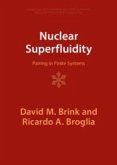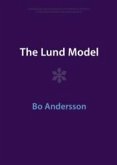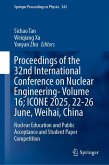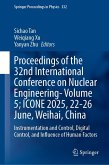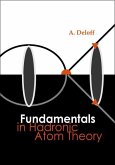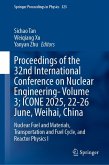E A Paschos
Electroweak Theory
E A Paschos
Electroweak Theory
- Gebundenes Buch
- Merkliste
- Auf die Merkliste
- Bewerten Bewerten
- Teilen
- Produkt teilen
- Produkterinnerung
- Produkterinnerung
Concise introduction to electroweak theory for graduate students and researchers in elementary particle physics.
Andere Kunden interessierten sich auch für
![Nuclear Superfluidity Nuclear Superfluidity]() David M BrinkNuclear Superfluidity133,99 €
David M BrinkNuclear Superfluidity133,99 €![The Lund Model The Lund Model]() Bo AnderssonThe Lund Model145,99 €
Bo AnderssonThe Lund Model145,99 €![Proceedings of the 32nd International Conference on Nuclear Engineering--Volume 16; Icone 2025, 22-26 June, Weihai, China Proceedings of the 32nd International Conference on Nuclear Engineering--Volume 16; Icone 2025, 22-26 June, Weihai, China]() Proceedings of the 32nd International Conference on Nuclear Engineering--Volume 16; Icone 2025, 22-26 June, Weihai, China174,99 €
Proceedings of the 32nd International Conference on Nuclear Engineering--Volume 16; Icone 2025, 22-26 June, Weihai, China174,99 €![Proceedings of the 32nd International Conference on Nuclear Engineering- Volume 5; Icone 2025, 22-26 June, Weihai, China Proceedings of the 32nd International Conference on Nuclear Engineering- Volume 5; Icone 2025, 22-26 June, Weihai, China]() Proceedings of the 32nd International Conference on Nuclear Engineering- Volume 5; Icone 2025, 22-26 June, Weihai, China151,99 €
Proceedings of the 32nd International Conference on Nuclear Engineering- Volume 5; Icone 2025, 22-26 June, Weihai, China151,99 €![Electroweak Structure and Reactions in Light Nuclei With Quantum Monte Carlo Methods Electroweak Structure and Reactions in Light Nuclei With Quantum Monte Carlo Methods]() Garrett B. KingElectroweak Structure and Reactions in Light Nuclei With Quantum Monte Carlo Methods104,99 €
Garrett B. KingElectroweak Structure and Reactions in Light Nuclei With Quantum Monte Carlo Methods104,99 €![Fundamentals in Hadronic Atom Theory Fundamentals in Hadronic Atom Theory]() Andrzej DeloffFundamentals in Hadronic Atom Theory131,99 €
Andrzej DeloffFundamentals in Hadronic Atom Theory131,99 €![Proceedings of the 32nd International Conference on Nuclear Engineering--Volume 3; Icone 2025, 22-26 June, Weihai, China Proceedings of the 32nd International Conference on Nuclear Engineering--Volume 3; Icone 2025, 22-26 June, Weihai, China]() Proceedings of the 32nd International Conference on Nuclear Engineering--Volume 3; Icone 2025, 22-26 June, Weihai, China174,99 €
Proceedings of the 32nd International Conference on Nuclear Engineering--Volume 3; Icone 2025, 22-26 June, Weihai, China174,99 €-
-
-
Concise introduction to electroweak theory for graduate students and researchers in elementary particle physics.
Produktdetails
- Produktdetails
- Verlag: Cambridge University Press
- Seitenzahl: 260
- Erscheinungstermin: 27. Juli 2023
- Englisch
- Abmessung: 244mm x 170mm x 16mm
- Gewicht: 612g
- ISBN-13: 9781009402385
- ISBN-10: 1009402382
- Artikelnr.: 68319116
- Herstellerkennzeichnung
- Libri GmbH
- Europaallee 1
- 36244 Bad Hersfeld
- gpsr@libri.de
- Verlag: Cambridge University Press
- Seitenzahl: 260
- Erscheinungstermin: 27. Juli 2023
- Englisch
- Abmessung: 244mm x 170mm x 16mm
- Gewicht: 612g
- ISBN-13: 9781009402385
- ISBN-10: 1009402382
- Artikelnr.: 68319116
- Herstellerkennzeichnung
- Libri GmbH
- Europaallee 1
- 36244 Bad Hersfeld
- gpsr@libri.de
Emmanuel Paschos is Professor of Physics at the University of Dortmund, Germany. He is a Fellow of the American Physical Society and of the Institute for Advanced Study, and a corresponding member of the Academy of Athens.
Preface
Part I. The Road to Unification: 1. The electromagnetic current and its properties
2. The weak currents
3. The quark model
Part II. Field Theories with Global or Local Symmetries: 4. Yang-Mills theories
5. Spontaneous breaking of symmetries
6. Construction of the model
7. The Higgs mechanism in the Glashow-Salam-Weinberg model
8. The leptonic sector
9. Incorporating hadrons
Part III. Experimental Consequences and Comparisons: 10. Deep inelastic scattering
11. Charged current reactions
12. Neutral currents in semileptonic reactions
13. Physics of neutrinos
14. Heavy quarks
15. CP violation: K mesons
16. CP violation: D and B mesons
17. Higgs particles
Epilogue
Appendix A. Conventions, spinors, and currents
Appendix B. Cross sections and traces
Appendix C. Identities for quark bilinears
Index.
Part I. The Road to Unification: 1. The electromagnetic current and its properties
2. The weak currents
3. The quark model
Part II. Field Theories with Global or Local Symmetries: 4. Yang-Mills theories
5. Spontaneous breaking of symmetries
6. Construction of the model
7. The Higgs mechanism in the Glashow-Salam-Weinberg model
8. The leptonic sector
9. Incorporating hadrons
Part III. Experimental Consequences and Comparisons: 10. Deep inelastic scattering
11. Charged current reactions
12. Neutral currents in semileptonic reactions
13. Physics of neutrinos
14. Heavy quarks
15. CP violation: K mesons
16. CP violation: D and B mesons
17. Higgs particles
Epilogue
Appendix A. Conventions, spinors, and currents
Appendix B. Cross sections and traces
Appendix C. Identities for quark bilinears
Index.
Preface
Part I. The Road to Unification: 1. The electromagnetic current and its properties
2. The weak currents
3. The quark model
Part II. Field Theories with Global or Local Symmetries: 4. Yang-Mills theories
5. Spontaneous breaking of symmetries
6. Construction of the model
7. The Higgs mechanism in the Glashow-Salam-Weinberg model
8. The leptonic sector
9. Incorporating hadrons
Part III. Experimental Consequences and Comparisons: 10. Deep inelastic scattering
11. Charged current reactions
12. Neutral currents in semileptonic reactions
13. Physics of neutrinos
14. Heavy quarks
15. CP violation: K mesons
16. CP violation: D and B mesons
17. Higgs particles
Epilogue
Appendix A. Conventions, spinors, and currents
Appendix B. Cross sections and traces
Appendix C. Identities for quark bilinears
Index.
Part I. The Road to Unification: 1. The electromagnetic current and its properties
2. The weak currents
3. The quark model
Part II. Field Theories with Global or Local Symmetries: 4. Yang-Mills theories
5. Spontaneous breaking of symmetries
6. Construction of the model
7. The Higgs mechanism in the Glashow-Salam-Weinberg model
8. The leptonic sector
9. Incorporating hadrons
Part III. Experimental Consequences and Comparisons: 10. Deep inelastic scattering
11. Charged current reactions
12. Neutral currents in semileptonic reactions
13. Physics of neutrinos
14. Heavy quarks
15. CP violation: K mesons
16. CP violation: D and B mesons
17. Higgs particles
Epilogue
Appendix A. Conventions, spinors, and currents
Appendix B. Cross sections and traces
Appendix C. Identities for quark bilinears
Index.



